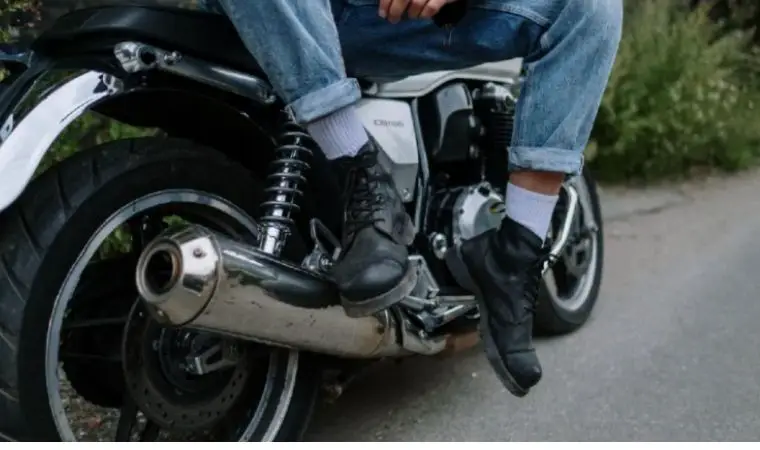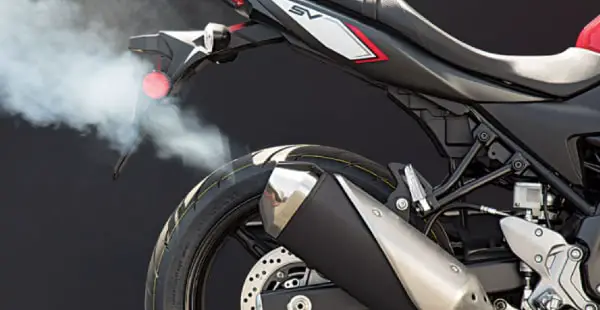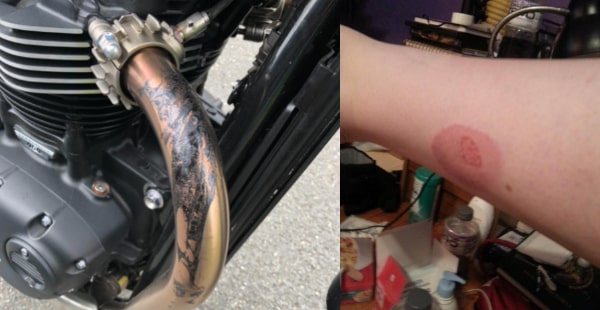Ever touched a motorcycle exhaust pipe and almost burnt your hand? Well, we’ve all been there. So you might be wondering why does it get hot.
We all know motorcycle engine’s power is produced by burning gasoline. The maximum portion of the power produced from it is used to run the motorbike. At the same time, the rest of it is eliminated through the motorcycle’s exhaust pipe.
As the exhaust pipe of the motorbike is used to eliminate the exhaust, so the question is, how hot does a motorcycle exhaust get. To know this, you also need to know the reasons behind the exhaust pipe getting hot and other related factors- which we’ll be explaining in this article.
Factors Behind Exhaust’s Temperature

Before we head on to the muffler temperature, first, it’s necessary to know why a motorcycle exhaust gets hot. Everything from burning gasoline and releasing the carbon particles into the atmosphere is related to exhausts temperature.
Combustion Temperature
In the motorcycle’s engine chamber, gasoline remains in compressed form. We know, at around 1600 degrees Fahrenheit, gasoline burns. So from this, we can estimate that the temperature inside the chamber remains around 1600 degrees F.
But in motorcycles with EGR or Exhaust Gas Recirculation, the temperature remains around 14-1600* F range.
Exhaust Pipe Temperature

If you look closely, the exhaust’s pipe head is narrower than its body. When the exhaust gases are leaving through the pipe, they get concentrated at the head. If you’re wondering, what is the temperature of engine exhaust, it’s seen that the exhaust pipe temperature goes to 700 degrees Fahrenheit. Depending on how well your exhaust transfers heat outside, the temperature of the motorcycle exhaust pipe’s head will vary.
The temperatures stated above, on the other hand, are based on a variety of engines and the weight you’re carrying on your motorcycle. The temperature will, of course, be lower if there’s an infrared red gauge present.
What is the normal operating temperature for a motorcycle? Well, the average temperature in an exhaust pipe can be between 700-1400 degrees Fahrenheit, which is very compared to normal heat and capable of causing heavy damage and burn when touched.
The exhaust’s pipe temperature can sometimes cross these limits and end up melting the pipe. So if you’re wondering how hot does a motorcycle’s exhaust gets, well, it depends on factors like engine and other factors.
Heat Production
When you ride the motorcycle, the engine produces the power from gasoline. The exhaust pipe removes heated waste gas from the machine before releasing it into the atmosphere through a hollow tube. The carbon exhaust will go from the exhaust manifold through a catalytic converter, then via some pipes before exiting through a exhaust pipe.
The volume of this exiting temperature is very large. So it’s quite impossible to calculate the exhaust gas’s accurate volume, let alone calculating the motorcycle’s exhaust pipe temperature
You’ll better understand how the muffler and the total gas exhaust system works when the bike is not moving. You can even watch the exhausting system as a whole and how the waste gas flows through the pipe part of the arrangement.
The pipe leading to the carburetor will heat up as soon as you start your bike. After a few seconds, the tail pipe will begin to sparkle as well. The exhaust system and muffler on your bike will then begin to filter a stream of hot air. However, after the air passes through the fuel system, you may rest assured that it will begin to cool. Surprisingly, the amount of heat created in all of your bike’s exhaust ports will be almost the same.
The oxygen sensor, on the other hand, becomes quite heated very quickly. It’s possible the hottest area in the total system. Air will flow down to the catalytic converter, where it will be blown out with waste or exhaust gases. Simply put, this entire region will get quite heated as a result of the procedure.
Motorcycle Exhaust Temperature: Preventing Accidents

You may probably guess that the temperatures are pretty high based on the responses to the question of how hot does motorcycle exhaust gets. Simultaneously, this means you should take all required care to avoid being hurt or burnt by the silencer.
Most motorcycle riders are unaware that exhaust pipe injuries are quite harmful. These types of burns by exhaust pipes are among the least known. Keeping in mind the catastrophic injuries you are likely to incur or may have already sustained, try to process how hot does a motorcycle exhaust gets. This should be enough to take action to protect yourself from hot exhaust pipes.
How To Prevent Accidents Related To Hot Mufflers And Exhaust Pipes
Here are a few things you may do to protect yourself from mufflers and exhaust burns:
- Use a heat shield available for exhaust pipes. You can use one this exhaust wrap up the hot exhaust pipe.
- Be careful while you start your bike.
- Make sure not to come in contact with the hot muffler while picking up or moving the bike.
- When riding with a child, be cautious, as youngsters are the ones who suffer the most burns from motorbike exhaust.
We believe you’ve grasped this. Keep in mind that muffler burn remedies differ depending on the severity of the burn. The most common burns from exhaust pipes are the second or third degree. According to a recent study, the symptoms of most of these incidents tend to diminish within about 20 days. If you still feel punch or pain after you have been burnt, it’s a positive indication.
However, you should seek emergency medical treatment if your leg becomes numb because this might indicate that the burn is extremely severe.
Most of the exhaust burns occur during hot and summertime. The reason is, during this time, both the interiors and the exterior temperature remains high. So the exhaust pipes hardly get time to cool down. That’s why you should always be careful of a hot exhaust pipe and prevent your body parts from touching or contacting it.
Extra Tips
Some additional tips to avoid muffler and silence pipe burns and protecting yourself are-
- You can clean the motorbike’s exhaust or tailpipe using a soap
- Use metal polish to remove the dirt on the stainless steel exhaust pipe’s wall
- First, let the exhaust pipe cool down and then touch them for any need
- Motorcycle exhaust systems tend to become loose due to vibration when riding. So keep all the screws and bolts tight.
Conclusion
How hot does a motorcycle exhaust get? Well, they are capable of incurring severe injuries like burning and causing bruises. Your bike’s exhaust pipes or tail pies get very hot when you start your motorbike and keeps riding. The more your die, the more gas exits and the hotter it becomes.
Before concluding, if you need to access the exhaust pipe in hot condition, you can wear gloves and other protective equipment to save yourself from injury. So next time when you’re working with a hot exhaust pipe or exhaust gases, keep these tips in mind. Good luck!
